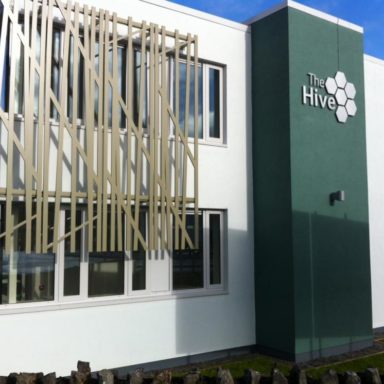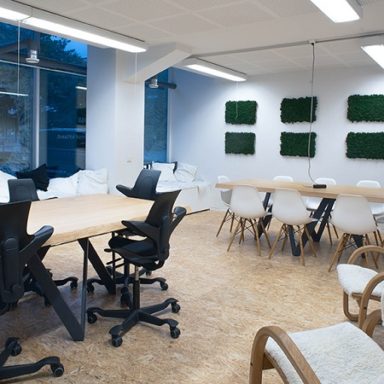The Network of Shared Creative Spaces aimed to share good practice and learning between existing Shared Creative Spaces across the five partner regions of ‘a creative momentum project’ and utilise these Spaces as locations for the delivery of other project activities and events. Our latest report ‘Network of Shared Creative Spaces: Profiling & Connecting Shared Creative Spaces across Europe’s Northern Edge’ examines the process of building this Network over the past three years.
The starting point was to define what exactly a ‘Shared Creative Space’ is. We agreed that a Shared Creative Space should meet the following criteria:
- Should house at least one creative business/entrepreneur with a view to housing at least one more.
- Should be a structure that provides four walls and a roof to any creative businesses that are working out of these premises.
- Should have a networking area.
In early 2016, each project partner compiled a database of Shared Creative Spaces in their own region. A total of 120 Shared Creative Spaces were identified across the five regions (Mid-Sweden, South East of Northern Ireland, Northern Finland, North East Iceland and West of Ireland).
Building the Network
After developing the database, a series of initiatives were put in place to establish a Network:
- Profile Spaces through MyCreativeEdge.eu: One of the new functionalities of the re-developed MyCreativeEdge.eu website was to allow owners and managers of Shared Creative Spaces to register on the site and publish a ‘Space Profile’ to showcase their Space, its facilities and also if it was currently seeking tenants. So far, 26 Space Profiles have been published on MyCreativeEdge.eu.
- Provide a mechanism to discuss and exchange best practice in relation to the management and running of Creative Spaces: A Creative Exchange event was held in Northern Ireland in November 2016 to engage with managers of Creative Spaces and capture information and advice relating to best practice for managing, funding or setting up a new Creative Space.
- Develop an online transnational Skype based Network: The next stage was to better network the Spaces transnationally. This was done via the promotion and delivery of Skype Network Con-Calls for managers of Creative Spaces in the partner regions to connect and share experiences. The first took place in March 2017, with further calls throughout 2017.
- Physical use of the Spaces for Creative Exchanges and transnational visits: Transnational visits to Spaces took place during partner meetings and Creative Hotspots. Creative Spaces were also used as venues for Creative Exchange information and networking events in all regions.
Observations
Creative Spaces:
- During the three years of the project many of the Creative Spaces engaged with went through substantial changes in personnel, funding, structure etc. It seems to be a fast-evolving sector.
- When it came to finding suitable venues for Creative Exchanges it was noted that Creative Spaces often met the needs of the event better than hotels. For example providing current reliable AV hardware with the expertise to deal with unforeseen issues.
- The majority of Creative Spaces that were renting space to creative businesses in the form of hot-desking, co-working space or private individual space were often part-funded from an external source.
Network of Shared Creative Spaces Con-Calls:
- It was difficult to set up the Skype Con-Calls due to the fact that not everyone had access to Skype and yet it was still the preferred method of everyone who wished to be on the calls. The level of WiFi dictated whether or not video was really practical.
- It was initially anticipated that calls would take place every month but it was very difficult to get availability of the members for such regular calls and ultimately they were less frequent.
- The members all expressed enthusiasm for the idea of the Network of Shared Creative Spaces Con-Calls, and all were keen to bring issues to the table.
Most Spaces engaged with primarily accommodated artists and crafters, with many owned/managed by artists or makers. These Spaces tend to be either currently receiving financial support or attempting to do so. There is however another type of Space which is a financially independent profit-making business that accommodates and provides working space for profit-based creative industries.
Future Development
Therefore any future development of this Network of Shared Creative Spaces should involve one Network which operates as an umbrella for two concurrent Networks that operate under it.
- Network of Artist and Crafter Spaces: The coordination of Spaces that have the specific goal of working together to better position themselves to avail of potential funding.
- Network of Digital Creatives: The development of a second Network of Shared Creative Spaces specific to creative digital entrepreneurs. This would involve networking digital/virtual spaces as these businesses are characterised as producing a digital product or service and are flexible in terms of working location. Through this Network they could be introduced to fellow creative digital entrepreneurs who may hold the possibility of future partnerships.
The full report and a Summary can be downloaded from the Knowledge Centre on MyCreativeEdge.eu.
Or download directly:
Network of Shared Creative Spaces: Summary & Lessons Learned (PDF, 0.4MB)
Network of Shared Creative Spaces: Profiling & Connecting Shared Creative Spaces across Europe’s Northern Edge (PDF, 1.6MB)




Discussion
You must be logged in to submit comments.
Add your comments here.
Maximum length of 500 characters